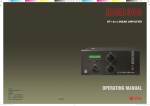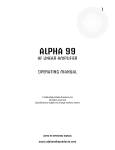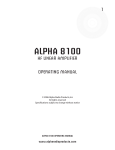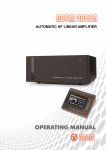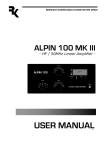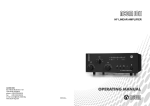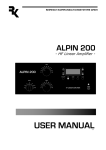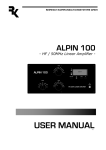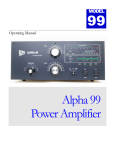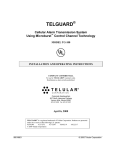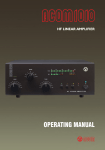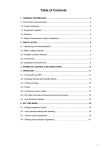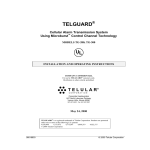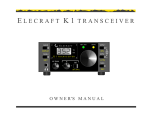Download ACOM 1010 user manual
Transcript
- G2 - when illuminated, a screen-grid overload condition exists; reduce the drive power and/or refresh the tuning (Section 4-5) for safe operation; - IP - when illuminated, a plate current overload condition exists; reduce the drive power and/or refresh the tuning (Section 4-5) for safe operation; - F – when illuminated, the amplifier automatic protection has tripped. If F is accompanied with one of the G1, G2, or IP condition indicators, the cause of the protection trip will be evident. When F alone is illuminated, check the keying wiring, Section 2-4(d). See Section 4-6 for details about the auto-protection system. 4. OPERATION Operation of the amplifier is simplified through ACOM’s innovative TRI tuning aid, Auto-Operate function, and automatic protection systems. To make full use of the amplifier’s potential and to configure it to local conditions, the following information should be read carefully. 4-1. Turning ON and OFF In order to turn on the amplifier, press the power switch ON at the bottom-right corner of the front panel. The LED indicator above the switch will glow green and the audible cooling fan will start. Following a series of automatic self-tests, the OPER LED will begin to flash green and will continue to do so during the 150-second warm-up period. Throughout this period, the amplifier will remain in the standby mode, and the transceiver may continue to be used. Also during this period, the A1-A2 button may be pressed to change antennas, i.e., between the antennas connected to the ANT1 and ANT2 terminals on the rear panel of the amplifier. Switching between the antennas does not affect the warm-up process. CAUTION To avoid damage not covered under warranty, do not change the antenna output during a transmission, i.e., never press the A1-A2 button when transmitting. NOTE When you intend to have a short operating break, it is better to place the amplifier in the standby mode rather than turning it off. Tube life is shortened by repeatedly turning it on and off. After the warm-up period is complete, the OPER LED stops flashing and remains illuminated green. 4-2. Changing Operate and Standby Modes The OPER button changes between two modes. When the green light above the button is illuminated, the amplifier will remain ready to operate, even automatically returning from standby after a high-drive protection trip. That is, after a protection trip, e.g., from an overdrive event, the amplifier will normally shift to the STBY mode for several seconds, but it will automatically return to the OPER mode after that. This is the Auto-Operate feature. Alternatively, the OPER button may be depressed manually to go to and remain in the STBY mode, such as when you leave the station for a while. The green LED goes off and the Auto-Operate function is suppressed temporarily. Pressing the OPER button again restores the Auto-Operate feature. 10 4-3. RTTY Mode Select the RTTY mode to operate continuous-duty modes such as RTTY, SSTV, or other data modes. The LED indicator above the RTTY button illuminates and the amplifier operating parameters are changed to reduce tube dissipation. In the RTTY mode, the amplifier output power is reduced to a maximum of 500 W. There is no need to adjust tuning when changing between RTTY and normal modes. CAUTION To avoid damage not covered under warranty, do not change modes during transmission. That is, do not change to or from RTTY or any other mode when transmitting. 4-4. Antenna change By pressing the A1-A2 button, the amplifier output is switched between the two corresponding antenna outputs, ANT1 and ANT2. The lights above the button indicate the current antenna selection. CAUTION To avoid damage (not covered under warranty) do not change the antenna during transmission. 4-5. Tuning Tuning is possible only in the OPER mode. a) Preliminary information. Tuning the amplifier involves a procedure of matching the impedance of the antenna and transmission line to the amplifier tube’s characteristic load resistance. This will ensure maximum plate efficiency and RF gain at nominal output power, with minimal distortion and spurious output. Note that REFLECTED POWER readings depend on the antenna and transmission line impedances only, and not on amplifier tuning. If the load impedance is not a nominally resistive 50-Ohms, the REFLECTED POWER reading will always show a reading, no matter what the tuning settings. Proper tuning is always necessary, however, and will allow you to operate at a high power level, without distortion or any danger to the amplifier. Note also that the real OUTPUT POWER presented to the load (the antenna and transmission line) is equal to the difference between the FORWARD and REFLECTED power readings. For instance, with a 2.5:1 VSWR, readings of 800 W and 150 W FORWARD POWER and REFLECTED POWER respectively, the real OUTPUT POWER is 650 W. At very high VSWR levels, such as when no antenna is connected or a badly mismatched antenna is used, the FORWARD and REFLECTED readings will be almost equal, while the real OUTPUT POWER (the difference between them) will be nearly zero. The amplifier can operate safely as long as the REFLECTED POWER is LESS THAN 250 W. Matching is assured for loads presenting a VSWR of up to 3:1. Nevertheless, for some loads and bands, matching is possible at even higher VSWR levels, but the drive power must be reduced to prevent the REFLECTED POWER from exceeding 250W. Failure to comply with these guidelines will cause the protection circuits to trip. For example, if the antenna VSWR were 5:1, the maximum attainable forward power would be 540 W, 240 W of reflected power and real output to the antenna and transmission line of only 300 W. In the event your antenna cannot be adjusted to produce a lower VSWR, an external antenna tuner may be deployed. 11 CAUTION At elevated VSWR levels, high voltages and high currents are distributed along the coaxial cable to the antenna, risking internal arcing and heat generation, and likely damage to the cable and any antenna switches that may be used. It is recommended that VSWR levels of more than 3:1 not be permitted with coaxial cable above 14 MHz. It is advisable to adjust amplifier tuning when antennas have been changed, snow has fallen, new objects are in the near field of the antenna, etc. Such changes may affect antenna impedance. NOTE If you use more than one antenna on a band, the proper antenna must be selected prior to performing the tuning procedure outlined below. CAUTION To avoid damage not covered under warranty, do not switch the BAND switch knob while transmitting. As discussed above, hot switching will damage the amplifier’s band switch! CAUTION Also, never apply drive longer than one minute continuously without pausing for at least one minute to allow the tube to cool. It is recommended that for initial tuning a frequency in the middle of the band be used. First, with no transceiver power applied, select the band. Then use Table 4-1 to achieve an approximate preset for both TUNE and LOAD capacitor knob settings: B LOAD Knob Dial TUNE Knob Dial 1.800 - 2.000 47 - 71 54 - 32 3.500 - 4.000 34 - 56 51 - 33 7.000 - 7.300 32 - 39 36 - 30 10.100 - 10.150 62 - 63 50 - 48 14.000 - 14.350 37 - 41 38 - 31 18.068 - 18.168 41 - 43 50 - 48 21.000 - 21.450 59 - 62 16 - 10 24.890 - 24.990 50 - 52 49 - 46 28.000 - 29.700 63 - 69 23 - 10 Table 4-1. Approximate tuning preset b) Tuning Procedure. (1) Once the antenna and band have been selected (and the TUNE and LOAD adjustments have been initially set as indicated in Table 4-1), apply between 10 and 20 W of continuous (key down CW) signal. (2) Look at the upper LED bar-graph (FORWARD POWER) and adjust the TUNE (right hand) capacitor for maximum indication. 2 (3) Watch the TRI indicator above the LOAD (left hand) capacitor and turn the LOAD capacitor in the indicated direction to center the green LED indicator light. (4) Increase the drive power to get the desired nominal output; then repeat steps (2) and (3), always peaking output with the TUNE adjustment. NOTE No light on the TRI indicator means that the tuning is too far off. To correct this, turn the LOAD and TUNE knobs around the table-suggested positions until the TRI indicator illuminates. no light: use TUNE knob for max. Power to get any marker tuning is far left: turn LOAD knob to the right to get the inside markers tuning is far right: turn LOAD knob to the left to get inside markers marker inside: turn LOAD knob slightly left to center it LOAD is tuned: turn TUNE knob to peak Forward Power Fig. 4-1. Using TRI tuning aid The TRI indicator will not illuminate until at least 20 W of forward power (output) is achieved. In the event successful matching cannot be accomplished, check the BAND switch position and antenna selection. Then check the antenna VSWR at the same drive frequency. d) Tuning hint. A benefit of TRI is that the knob positions are virtually independent. The plate-load resistance decreases to the right and increases to the left of the TRI center. A centered tuning indication corresponds to the proper LOAD capacitor tuning, which presents an optimum load resistance to the tube. If the LOAD knob is turned to the left with a centered TRI, there will be more gain, but less linearity. When available drive power is insufficient or when less output but better efficiency are needed, e.g., for RTTY and SSTV, this may be desirable. Tuning to the right of the center would lead to the opposite result, i.e., less gain and more power attainable. Of course, this requires more drive power, more plate current, and more plate heat, which shortens tube’s-expected life. Off -center tuning may also be used to compensate for line (mains) voltage variations in order to maintain tube efficiency. In that case, tune to the left when line (mains) voltage is high, or tune to the right if it is low. However, where there is more than a 10% difference from the nominal line (mains) voltage, the voltage selector inside the amplifier should be changed. See Section 2-2 (Line Voltage Selection). 4-6 The Auto-Protection System When any abnormal amplifier condition is detected by the auto-protection microprocessor, the risk will be evaluated automatically and either of two levels of protection will be applied: a) The first degree of protection consists of an illuminated LED warning. These include the yellow LED warnings discussed earlier, i.e., “G1” (grid 1), “G2,” (grid 2), and “IP” (plate). Operation may be continued but the amplifier is likely to proceed to the second degree of protection, the trip. b) The second degree of protection is a trip to the standby mode. The red “F” (fault) LED illuminates and the amplifier automatically goes to the standby mode for several seconds. Also, the green OPER LED goes off. The amplifier will indicate the reason for the protection trip: 13 - if one of the yellow (G1, G2, IP) warning LEDs is illuminated along with the “F” LED, a current limit has been exceeded; drive power must be reduced or retuning is necessary; - if the last red LED of the reflected-power bar-graph is illuminated together with the “F” LED, the reflected-power limit has been exceeded; the drive must be reduced or the antenna VSWR must be improved. - if all three LEDs of the TRI are flashing simultaneously together with the “F” LED, the tuning is not adjusted correctly; most likely the antenna impedance has changed and retuning is required. Fault information normally remains on the display for several seconds while the amplifier is in the standby mode. The auto-operate function will attempt to return the amplifier to the operate mode automatically. If the protection trips repeatedly, the user must attend to the cause of the trip, which is typically too much drive or antenna mismatch. CAUTION If all LEDs in the bar-graph area are flashing simultaneously, you must immediately switch off the amplifier to avoid damage. 5. MAINTENANCE If no indicator glows upon switching the amplifier on, the main fuse(s) may have blown. See Section 5-2. 5-1. Cleaning WARNING Do not use solvents for cleaning as they may be dangerous to you and damage amplifier surfaces and plastic components. Do not open the amplifier. Cleaning the amplifier outer surface may be safely accomplished by using a piece of soft cotton cloth lightly moistened with clean water. 5-2. Fuse Replacement WARNING If your amplifier is only fitted with one line (mains) fuse, it is suitable for the European Community ONLY. Your dealer will check that your amplifier is correctly fused before it is shipped to you, based upon your indicated location. Customers should check with a qualified electrician if the amplifier is to be used outside the country in which it was purchased. CAUTION For 120 V ac operation, the fuses should be rated at 10 A; for 240 V ac operation, the fuses should be rated at 6.3 A. If it is necessary to replace the line (mains) fuses, use only those that are permitted under local safety codes. 4 The two primary line (mains) fuses in the amplifier are located on the rear panel (Fig. 2-1). They are of the fast (quick blow) type, European size 5 x 20 mm. Use 10 A for 100-120 V ac operation; 6.3 A for 200-240 V ac operation. Suitable types are: For 120 V: 10 A 250 V 5 x 20 mm fast (quick blow), LITTELFUSE 0217010; Wickmann 1942100000 For 240 V: 6.3 A 250 V 5 x 20 mm fast (quick blow), LITTELFUSE 021706.3; Wickmann 1931630000 Besides the primary fuses, there are also fuses located on the HV PCB and on the MAINS PCB (inside the amplifier). They are European size 5 x 20 mm, 0.8 A, 2 A and 5 A, time lag (slow-blow) type. Suitable types are: HV PCB: 2 A 250 V SLOW BLOW (Time Lag) 5 x 20 mm; LITTELFUSE 0218002; Wickmann 1951200000 MAINS PCB: 5 A 250 V SLOW BLOW (Time Lag) 5 x 20 mm; LITTELFUSE 0218005; Wickmann 1951500000 MAINS PCB: 0.8 A 250 V SLOW BLOW (Time Lag) 5 x 20 mm; BUSSMANN type S504-800mA These latter fuses must not be replaced by the user. Replacing these internal fuses is potentially dangerous and must be done only by a trained service technician. Contact your ACOM dealer for assistance. 5-3. Tube Replacement A single Svetlana 4CX800A (GU74B) high-performance ceramic-metal tetrode is used in the amplifier. Replacement is a complex and potentially dangerous operation that involves adjustment of the plate idling current. This should not be attempted by the user. Contact your ACOM dealer. 5-4. Simplified Schematic Diagram See Fig. 5-1 ACOM1010 Simplified* Schematic Diagram. The 4CX800A (GU74B) Svetlana high performance ceramic-metal tetrode (V1) with plate dissipation of 800 W is grid-driven. The input signal from the RF INPUT jack is passed through a broadband input matching circuit, which consists of components on the INPUT PCB and includes the drive-power swamping resistor Rsw. This circuit tunes out the input capacitance of the tube. The swamping resistor Rsw is a termination load for the matching circuit and can dissipate up to 80 W of RF drive power. It also eliminates any tendency toward oscillation by the tube, ensuring excellent RF stability of the amplifier. The cathode resistor Rc creates DC and RF negative feedback, thus stabilizing gain and equalizing frequency response. The combination Lp1-Rp1 in the plate circuit is a VHF/UHF parasitic suppressor. DC plate voltage is fed through chokes RFC1-RFC2 and the capacitor Cb3 blocks it from the output. The output tank, comprised of LP1, LP2, LL, CP1-CP3, and CL1-CL4 , forms a classic Pi-L network and suppress harmonic frequency emissions. This circuit is switched and tuned by S1A-S1C and the air variable capacitors CP1, 2 and CL1, 2. The output signal is fed through the antenna relays K1 and K2 in the WATTMETER PCB. The WATTMETER PCB also includes a high-pass filter for frequencies below 100 kHz, and it prevents the plate supply from reaching the antenna. The plate RF voltage is monitored through the capacitor Ca and together with the RF WATTMETER is the main source of information for the control circuit of the amplifier in evaluating tuning quality. The control circuit is based on the ATMEGA-8L micro-controller from Atmel. All voltages are delivered from the line (MAINS) and HV PCBs. The currents of the control grid, screen grid, and the plate, as well as the reflected power and tuning quality, etc., are continuously monitored by the micro-controller. Many 15 software-derived protections are based on this information. * Detailed electrical schematic diagrams are available from ACOM or from your dealer on request. 5-5. Service Functions By pressing the OPER and RTTY buttons simultaneously, the upper LED bar-graph is switched to the service mode, which is indicated by both red bar-graph lights and the yellow G1 light illuminating. Pressing the OPER and RTTY buttons together again will select additional service measurement functions. Pressing them a final time will return the amplifier to the normal operating mode. These steps are detailed below: a) Press the OPER and RTTY buttons together. The two red lights on the right side of the upper bar-graph will illuminate to confirm that the amplifier is in the service mode. The yellow G1 light will also illuminate. The upper bar-graph should show a grid 1 current reading no higher than 5 mA (5 LEDs illuminated). b) Pressing the OPER and RTTY buttons once again will now illuminate the yellow G2 light. This provides an approximate reading of grid 2 voltage. The upper bar graph should show a voltage reading within the range of either 270-300 Volts (9-10 LEDs illuminated) for RTTY or 210-330 Volts (7 to 11 LEDs illuminated) for SSB and CW. c) Pressing the OPER and RTTY buttons yet again will illuminate the yellow IP light. This provides an approximate reading of combined plate current and grid 2 current. The reading should be no higher than 500 mA (10 LEDs illuminated) for RTTY or 600 mA (12 LEDs illuminated) for SSB and CW. d) Pressing the OPER and RTTY buttons a final time will restore the upper bar-graph to its normal function of indicating peak forward power. NOTE The auto-protection system will continue to operate in the service mode. 6. SPECIFICATIONS 6-1. Parameters a) Frequency Coverage: All amateur bands in the 1.8-29.7MHz frequency range; extensions and/or changes on request. b) Power Output: 700 W PEP or 500 W continuous carrier. c) Intermodulation Distortion: Better than 35 dB below rated output. d) Hum and noise: Better than 40 dB below rated output. e) Harmonic Output Suppression: Better than 50 dB below rated output. f) Input and Output Impedance: - Nominal value: 50 Ohm unbalanced, UHF (SO-239) type connectors; - Input circuit: broadband, VSWR less than 1.3:1, 1.8-30 MHz continuously (no tuning, no switching); 6








